Submitted:
15 February 2024
Posted:
16 February 2024
You are already at the latest version
Abstract
Keywords:
1. Introduction
2. Materials and Methods
2.1. Study Areas, Soil Bedrock and Sampling
2.2. Field Analyses
2.3. Laboratory Analysis of Disturbed Soils Samples
2.4. Laboratory Analysis of Undisturbed Soils Samples
2.5. Statistical Analyses
3. Results
3.1. Physical Properties
3.2. Chemical and Morphological Properties
3.3. Micromorphological Descriptions and Micromorphometric Calculations
4. Discussion
4.1. Factors Affecting SOM Storage
4.2. Drivers of Natural and Mining/Industrial Soil Formation
4.3. Share of Aggregation and Pore Structure in SOM Storage: Effect of Excessive amounts of Zn, Pb and Cd in the Mining/Industrial Soils
Author Contributions
Funding
Institutional Review Board Statement
Informed Consent Statement
Data Availability Statement
Conflicts of Interest
Appendix A
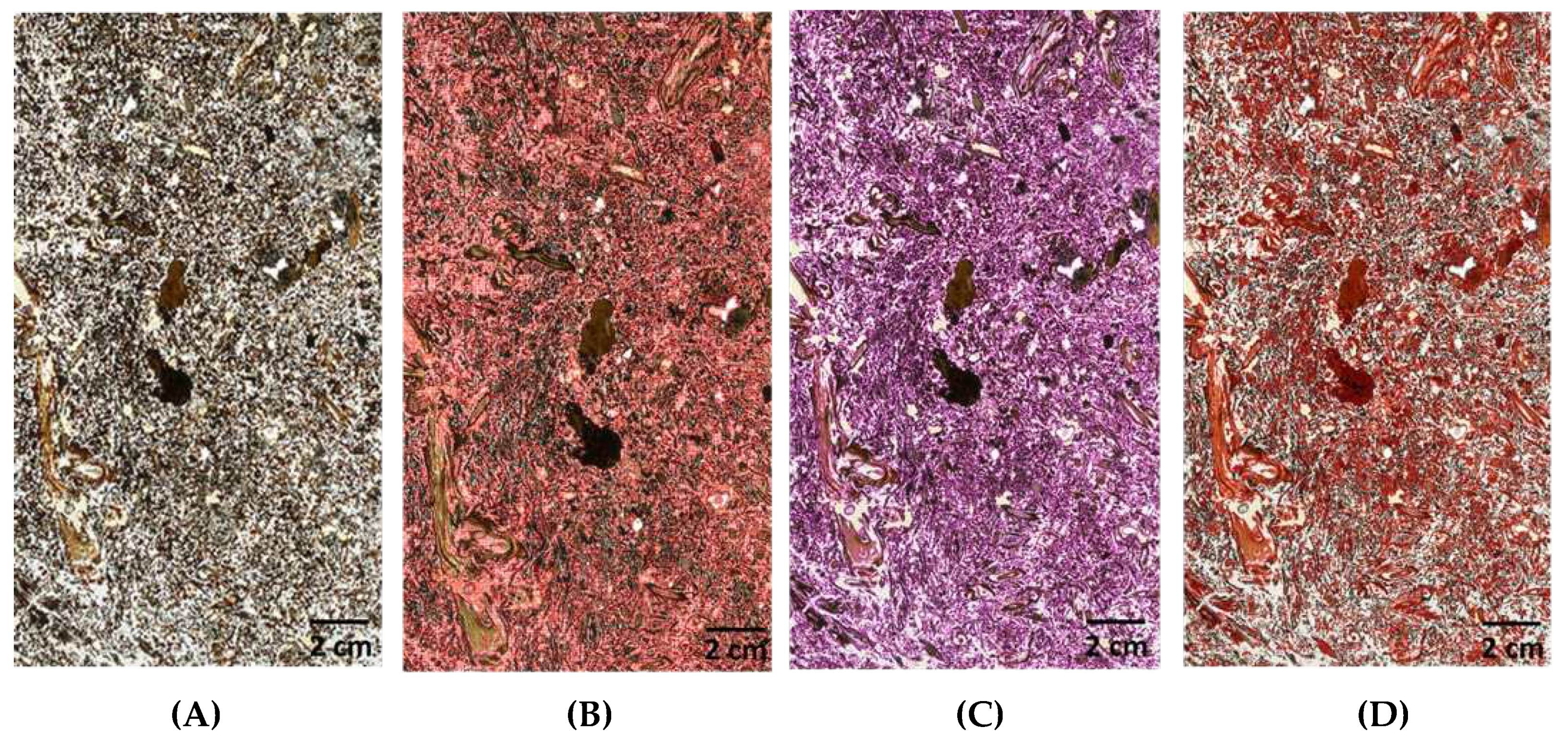
| Soil | c/f related distribution | Coarse material | Microstructure | Pores | Other observations |
|---|---|---|---|---|---|
| Natural soils | |||||
| Gac, Chot |
double spaced enaulic |
grains of quartz and gypsum, some calcite |
crumb microstructure with porous, sub-rounded and highly separated macroaggregates containing micro-aggregates (composed of amorphous organic material of animal origin and phlobaphene containing tissues) |
compound packing voids abundant thin, interconnected textural pores |
fauna droppings of about 400 µm composed of small aggregates of 25-50 µm |
| Bus Bus-L |
double spaced enaulic | grains of quartz and gypsum some calcite |
crumb microstructure with porous spheroidal and highly separated aggregates within macroaggregates micro-aggregates composed of amorphous organic material of animal origin |
complex packing voids abundant thin, interconnected textural pores |
fauna droppings (c. 400 µm) composed of small aggregates of 25-50 µm, medium decomposed organ residues (roots) |
| Old brownfield soils | |||||
| Buk-W Buk |
open porphyric | grains of quartz and a few grains of calcite |
highly separated granular, small slightly porous aggregates (c. 100-200 µm) |
compound packing voids few textural pores |
abundant organ residues (roots) yellowish to reddish (slightly decomposed)charcoal pieces, fauna droppings |
| Brownfield soils | |||||
| Jaw | open porphyric | grains of quartz |
highly separated granular, small and non-porous aggregates (c. 100-200 µm) |
compound packing voids few textural pores |
few organ residues, more tissue residues |
| NH | chitonic | abundant grains of quartz and some calcite grains |
vughy some small non-porous aggregates (c. 100-200 µm) |
numerous vughs |
abundant, yellowish to reddish organ residues (roots), some fine amorphous organic, material |
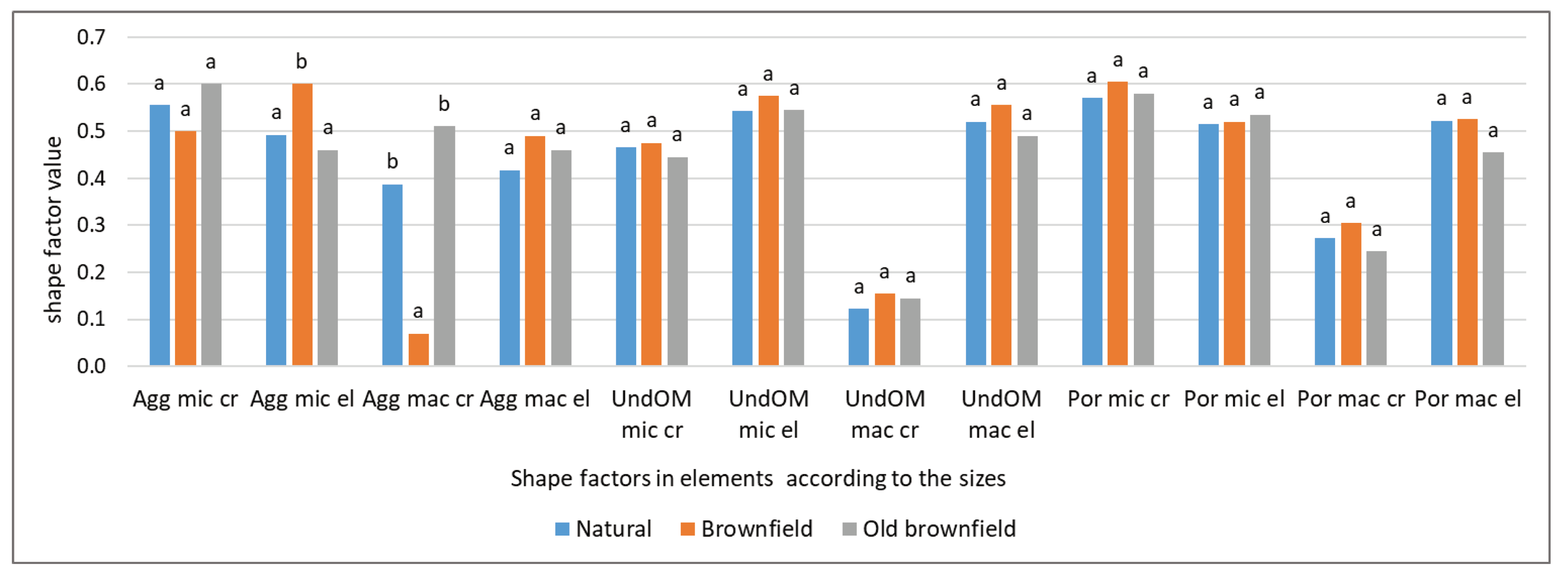
References
- Falsone, G.; Wilson, C.A.; Cloy, J.M.; Graham, M.C.; Bonifacio, E. Relating Microfeatures of Soil Organic Matter to C Stabilisation: Optical Microscopy, SEM-EDS, Abiotic Oxidation. Biol Fertil Soils 2014, 50, 623–632. [Google Scholar] [CrossRef]
- Laudicina, V.A.; Dazzi, C.; Delgado, A.; Barros, H.; Scalenghe, R. Relief and Calcium from Gypsum as Key Factors for Net Inorganic Carbon Accumulation in Soils of a Semiarid Mediterranean Environment. Geoderma 2021, 398, 115115. [Google Scholar] [CrossRef]
- Čížková, B.; Woś, B.; Pietrzykowski, M.; Frouz, J. Development of Soil Chemical and Microbial Properties in Reclaimed and Unreclaimed Grasslands in Heaps after Opencast Lignite Mining. Ecological Engineering 2018, 123, 103–111. [Google Scholar] [CrossRef]
- Poch, R.M.; Virto, I. Micromorphology Techniques for Soil Organic Carbon Studies. In Soil Carbon; 2014; pp. 17–27. [Google Scholar]
- Lützow, M.V.; Kögel-Knabner, I.; Ekschmitt, K.; Matzner, E.; Guggenberger, G.; Marschner, B.; Flessa, H. Stabilization of Organic Matter in Temperate Soils: Mechanisms and Their Relevance under Different Soil Conditions—A Review. European J Soil Science 2006, 57, 426–445. [Google Scholar] [CrossRef]
- Rabot, E.; Wiesmeier, M.; Schlüter, S.; Vogel, H.-J. Soil Structure as an Indicator of Soil Functions: A Review. Geoderma 2018, 314, 122–137. [Google Scholar] [CrossRef]
- Aznar, J.M.; Badía Villas, D.; Poch, R.M. Soil Catena along Gypseous Woodland in the Middle Ebro Basin: Soil Properties and Micromorphology Relationships. Span. J. Soil Sci. 2014, 2, 173. [Google Scholar] [CrossRef]
- VandenBygaart, A.J.; Fox, C.A.; Fallow, D.J.; Protz, R. Estimating Earthworm-Influenced Soil Structure by Morphometric Image Analysis. Soil Science Soc of Amer J 2000, 64, 982–988. [Google Scholar] [CrossRef]
- Aydemir, S.; Keskin, S.; Drees, L.R. Quantification of Soil Features Using Digital Image Processing (DIP) Techniques. Geoderma 2004, 119, 1–8. [Google Scholar] [CrossRef]
- Zaiets, O.; Poch, R.M. Micromorphology of Organic Matter and Humus in Mediterranean Mountain Soils. Geoderma 2016, 272, 83–92. [Google Scholar] [CrossRef]
- Singh, J.P.; Vaidya, B.P.; Goodey, N.M.; Krumins, J.A. Soil Microbial Response to Metal Contamination in a Vegetated and Urban Brownfield. Journal of Environmental Management 2019, 244, 313–319. [Google Scholar] [CrossRef]
- Zhong, X.; Chen, Z.; Li, Y.; Ding, K.; Liu, W.; Liu, Y.; Yuan, Y.; Zhang, M.; Baker, A.J.M.; Yang, W.; et al. Factors Influencing Heavy Metal Availability and Risk Assessment of Soils at Typical Metal Mines in Eastern China. Journal of Hazardous Materials 2020, 400, 123289. [Google Scholar] [CrossRef] [PubMed]
- Bosch-Serra, A.D.; Cruz, J.; Poch, R.M. Soil Quality in Rehabilitated Coal Mining Areas. Applied Sciences 2023, 13, 9592. [Google Scholar] [CrossRef]
- Świątek, B.; Woś, B.; Chodak, M.; Maiti, S.K.; Józefowska, A.; Pietrzykowski, M. Fine Root Biomass and the Associated C and Nutrient Pool under the Alder (Alnus Spp.) Plantings on Reclaimed Technosols. Geoderma 2019, 337, 1021–1027. [Google Scholar] [CrossRef]
- Slukovskaya, M.V.; Vasenev, V.I.; Ivashchenko, K.V.; Morev, D.V.; Drogobuzhskaya, S.V.; Ivanova, L.A.; Kremenetskaya, I.P. Technosols on Mining Wastes in the Subarctic: Efficiency of Remediation under Cu-Ni Atmospheric Pollution. International Soil and Water Conservation Research 2019, 7, 297–307. [Google Scholar] [CrossRef]
- Abiven, S.; Menasseri, S.; Chenu, C. The Effects of Organic Inputs over Time on Soil Aggregate Stability – A Literature Analysis. Soil Biology and Biochemistry 2009, 41, 1–12. [Google Scholar] [CrossRef]
- Blazejewski, G.A.; Stolt, M.H.; Gold, A.J.; Groffman, P.M. Macro- and Micromorphology of Subsurface Carbon in Riparian Zone Soils. Soil Science Soc of Amer J 2005, 69, 1320–1329. [Google Scholar] [CrossRef]
- Virto, I.; Barré, P.; Enrique, A.; Poch, R.M.; Fernández-Ugalde, O.; Imaz, M.J.; Bescansa, P. Micromorphological Analysis on the Influence of the Soil Mineral Composition on Short-Term Aggregation in Semi-Arid Mediterranean Soils. Span. J. Soil Sci. 2014, 3, 179. [Google Scholar] [CrossRef]
- Poch, R.M.; de Coster, W.; Stoops, G. Geoderma. Pore space characteristics as indicators of soil behaviour in gypsiferous soils 1998, 87, 87–109. [Google Scholar]
- De Carvalho, M.; Ciarkowska, K.; Miechówka, A. Storage of Persistent Organic Matter in Temperate Gypsum Soils –Relevance of the Parent Material and Vegetation Cover. Geoderma 2023, 435, 116522. [Google Scholar] [CrossRef]
- Ciarkowska, K.; Niemyska-Łukaszuk, J. Microstructure of Humus Horizons of Gypsic Soils from the Niecka Nidziańska Area (South Poland). Geoderma 2002, 106, 319–329. [Google Scholar] [CrossRef]
- Urban, J.; Chwalik-Borowiec, A.; Kasza, A. Biuletyn Państwowego Instytutu Geologicznego. The development and age of the karst in gypsum deposits of the Nicka Solecka (Solec Basin) area 2015, 462, 125–152. [Google Scholar]
- Ciarkowska, K.; De Carvalho, M.; Gambus, F. Analysis of Polycyclic Aromatic Hydrocarbons (PAHs) Sources and Vertical Distribution in Soils of the Age-Diverse Brownfields of Southern Poland Using Positive Matrix Factorisation and Data Mining Model. Sustainability 2022, 14, 13796. [Google Scholar] [CrossRef]
- Jahn, R.; Blume, H.P.; Asio, V.; Spaargaren, O.; Schad, P. Guidelines for Soil Description, 4th ed.; FAO: Rome, Italy, 2006. [Google Scholar]
- Oyama, M.; Takehara, H. Revised Standard Soil Color Charts; Research Council for Agriculture, Forestry and Fisheries: Japan, 1970. [Google Scholar]
- Mazurek, R.; Kowalska, J.; Gąsiorek, M.; Setlak, M. Micromorphological and Physico-Chemical Analyses of Cultural Layers in the Urban Soil of a Medieval City — A Case Study from Krakow, Poland. CATENA 2016, 141, 73–84. [Google Scholar] [CrossRef]
- Sokołowska, J.; Józefowska, A.; Zaleski, T. Humus Horizon Development during Natural Forest Succession Process in the Polish Carpathians. J. Mt. Sci. 2022, 19, 647–661. [Google Scholar] [CrossRef]
- IUSS Working Group World Reference Base for Soil Resources. International Soil Classification System for Naming Soils and Creating Legends for Soil Maps; 4th-th ed.; International Union of Soil Sciences: Vienna, Austria, 2022. [Google Scholar]
- Tan, K.T. Soil Sampling, Preparation and Analysis; Taylor & Francis Group: Boca Raton, USA, 2005. [Google Scholar]
- Cassida, L.E.; Klein, D.A.; Santoro, T. Soil Science. Soil dehydrogenase activity 1964, 98, 371–376. [Google Scholar]
- Blake, G.R.; Hartge, K.H. Particle Density. In Methods of Soil Analysis, Part 1: Physical and Mineralogical Methods; American Society of Agronomy: Madison, WI, USA, 1986; Volume 9, pp. 377–382. [Google Scholar]
- Otsu, N. A Threshold Selection Method from Gray-Level Histograms. IEEE Trans. Syst., Man, Cybern. 1979, 9, 62–66. [Google Scholar] [CrossRef]
- Stoops, G. Guidelines for Analysis and Description of Soil and Regolith Thin Section; Soil Sci. Soc. Am. Inc.: Madison, Wisconsin, USA, 2003. [Google Scholar]
- StatSoft Inc. Statistica (Data Analysis Software System). 2019. [Google Scholar]
- ter Braak, C.J.F.; Smilauer, P. Canoco Reference Manual and User’s Guide: Software for Ordination, version 5.1; 2012. [Google Scholar]
- Gupta, V.V.S.R.; Germida, J.J. Soil Aggregation: Influence on Microbial Biomass and Implications for Biological Processes. Soil Biology and Biochemistry 2015, 80, A3–A9. [Google Scholar] [CrossRef]
- Fernández-Ugalde, O.; Virto, I.; Barré, P.; Gartzia-Bengoetxea, N.; Enrique, A.; Imaz, M.J.; Bescansa, P. Effect of Carbonates on the Hierarchical Model of Aggregation in Calcareous Semi-Arid Mediterranean Soils. Geoderma 2011, 164, 203–214. [Google Scholar] [CrossRef]
- Bieganowski, A.; Zaleski, T.; Kajdas, B.; Sochan, A.; Józefowska, A.; Beczek, M.; Lipiec, J.; Turski, M.; Ryżak, M. An Improved Method for Determination of Aggregate Stability Using Laser Diffraction. Land Degrad Dev 2018, 29, 1376–1384. [Google Scholar] [CrossRef]
- Alvarez, M.F.; Poch, R.M.; Osterrieth, M. Bioporosity in Thin Sections of Luvic Phaeozems of Southeast of Buenos Aires, Argentina, and Its Possible Role as an Indicator of Soil Quality. An Micromorphological Approach. Eurasian Soil Sc. 2021, 54, 918–926. [Google Scholar] [CrossRef]
- Ciarkowska, K.; Gargiulo, L.; Mele, G. Natural Restoration of Soils on Mine Heaps with Similar Technogenic Parent Material: A Case Study of Long-Term Soil Evolution in Silesian-Krakow Upland Poland. Geoderma 2016, 261, 141–150. [Google Scholar] [CrossRef]
- Johannes, A.; Weisskopf, P.; Schulin, R.; Boivin, P. Soil Structure Quality Indicators and Their Limit Values. Ecological Indicators 2019, 104, 686–694. [Google Scholar] [CrossRef]
- Rasa, K.; Eickhorst, T.; Tippkötter, R.; Yli-Halla, M. Structure and Pore System in Differently Managed Clayey Surface Soil as Described by Micromorphology and Image Analysis. Geoderma 2012, 173–174, 10–18. [Google Scholar] [CrossRef]
- Ciarkowska, K.; Sołek-Podwika, K.; Wieczorek, J. Enzyme Activity as an Indicator of Soil-Rehabilitation Processes at a Zinc and Lead Ore Mining and Processing Area. Journal of Environmental Management 2014, 132, 250–256. [Google Scholar] [CrossRef] [PubMed]
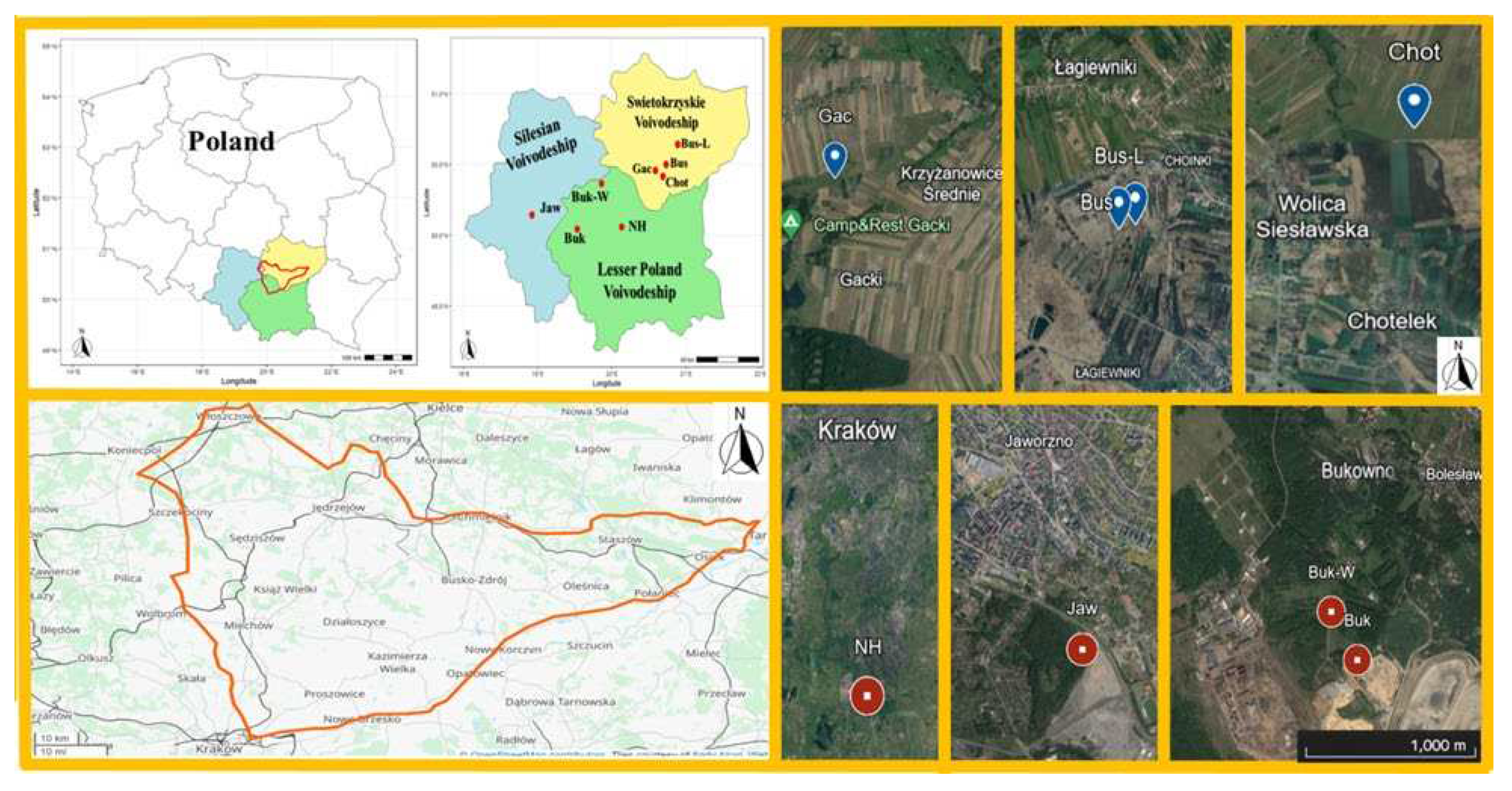
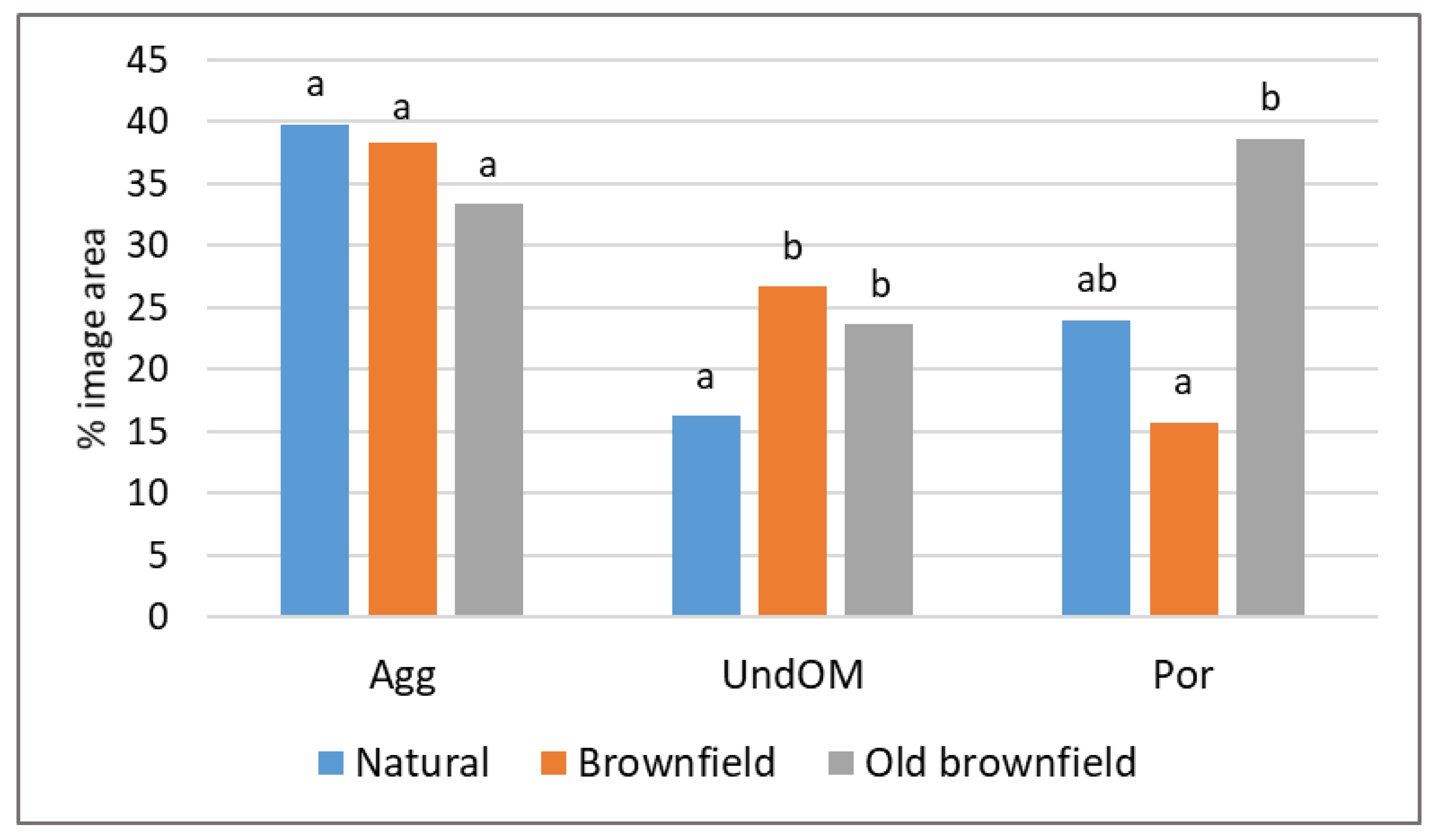
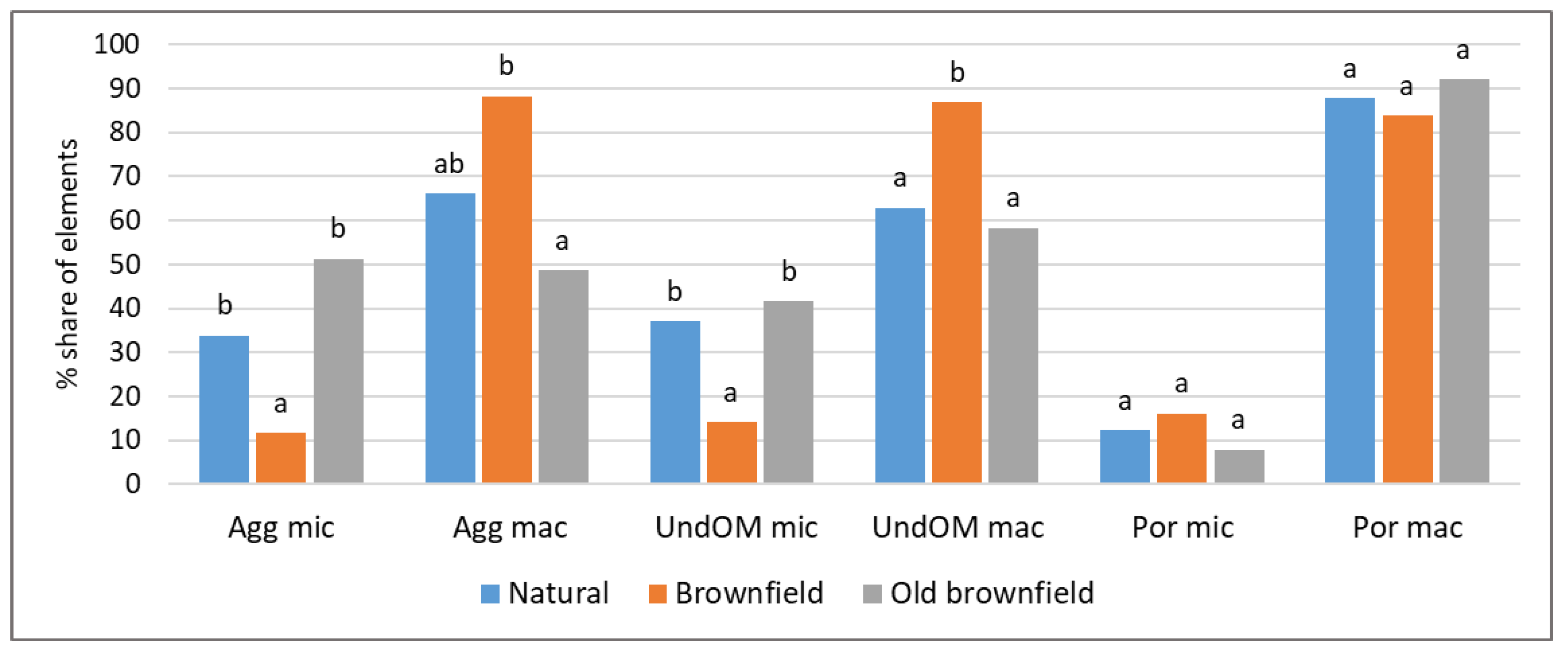
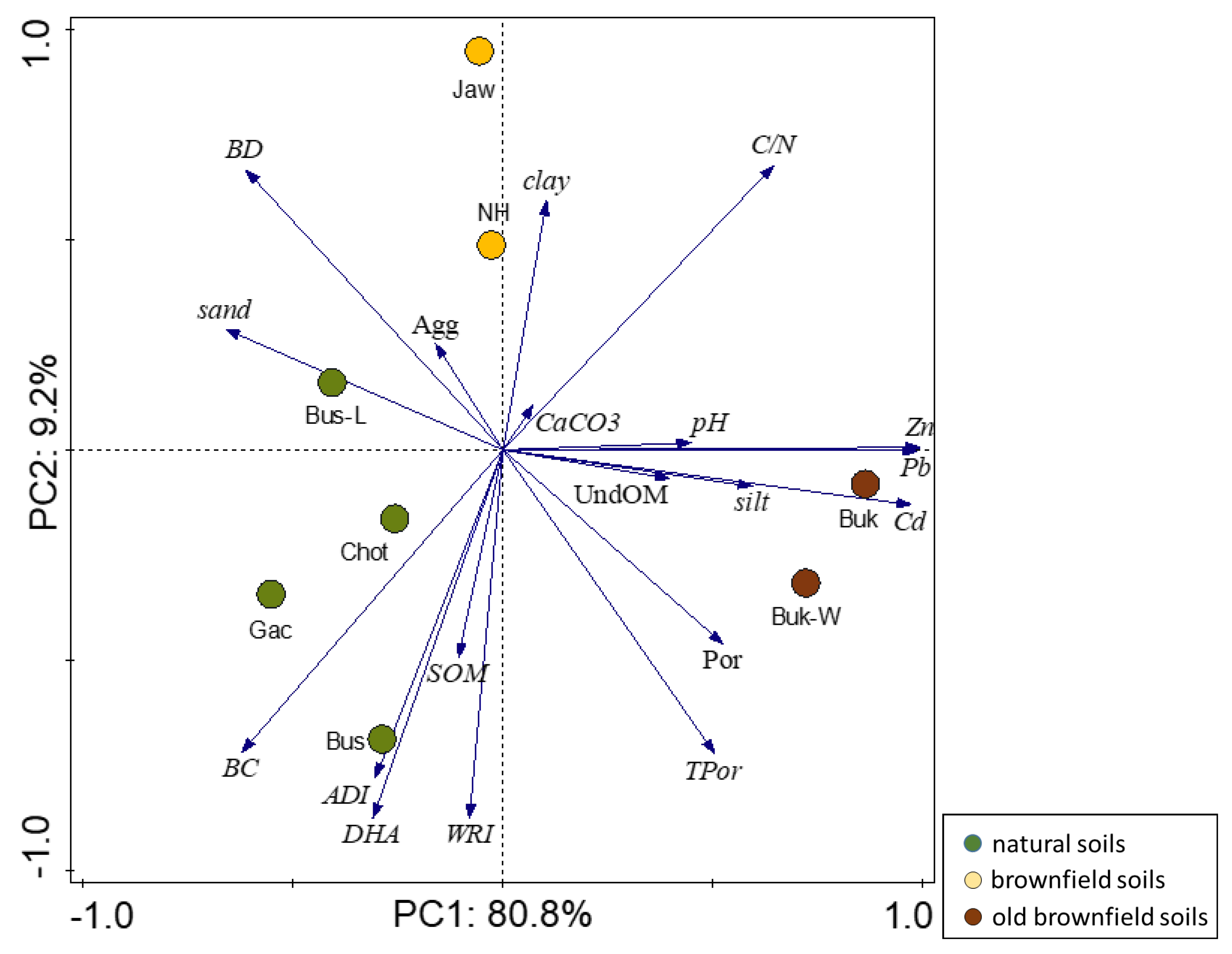
| Soils | Sand % |
silt % |
clay % |
Macrostructure1 – grade, size, shape | WRI2 | BD3 g/cm3 |
TPor4 % |
|
|---|---|---|---|---|---|---|---|---|
| Natural soils | ||||||||
| Gac | 59.9b* ±5.15 |
29.1a ±3.4 |
11ab ±3 |
strong, fine granular | 0.98c ±0.21 |
0.96b ±0.10 |
63b ±2 |
|
| Bus-L | 68b ±2 |
24a ±5.1 |
8a ±3.4 |
moderate, medium granular | 0.75c ±0.15 |
0.98b ±0.09 |
61b ±3 |
|
| Bus | 6.1a ±2.3 |
89.9b ±5.8 |
4a ±3.5 |
strong → moderate, fine granular |
0.87c ±0.14 |
0.87b ±0.11 |
65b ±2 |
|
| Chot | 11.7ab ±5.6 |
74.3b ±9.6 |
14b ±2 |
strong → moderate, fine granular |
0.84c ±0.18 |
1.20b ±0.10 |
52ab ±2 |
|
| Brownfield soils | ||||||||
| Jaw | 21.2ab ±5.8 |
65.8b ±12.4 |
13b ±1.2 |
weak, coarse, blocky angular →crumbly |
0.18a ±0.08 |
1.46c ±0.12 |
44a ±4 |
|
| NH | 12.6ab ±2.3 |
73.4b ±3.6 |
14b ±2.3 |
moderate, very thick, platy →fine, crumbly |
0.42b ±0.10 |
1.50c ±0.20 |
43a ±4 |
|
| Old brownfield soils | ||||||||
| Buk-W | 4.6a ±3.5 |
84.4b ±6.7 |
11a ±1 |
moderate, medium, single grained → blocky angular |
0.51b ±0.10 |
0.55a ±0.11 |
78c ±3 |
|
| Buk | 8.6a ±4.2 |
82.4b ±5.5 |
9a ±3 |
single grained → blocky angular | 0.57b ±0.12 |
0.56a ±0.13 |
78c ±2 |
|
| Soils | pH | BC1 mmol+/kg |
CaCO3 % |
SOM % |
C/N | DHA2 mgTPF/kg/24h |
Zn | Pb | Cd |
|---|---|---|---|---|---|---|---|---|---|
| mg/kg | |||||||||
| Natural soils | |||||||||
| Gac | 7.0ab* ±0.12 |
1205c ±230 |
5.7b ±0.4 |
7.7b ±0.1 |
8.4a ±0.1 |
102.8d ±10.0 |
15.09a ±0.15 |
5.79a 0.21 |
0.30a ±0.10 |
| Bus-L | 6.4a ±0.2 |
534.1b ±25 |
1.9a ±0.4 |
14.5c ±0.2 |
9.3a ±0.1 |
57.42bc ±4.70 |
27.00a ±0.32 |
24.09b ±1.65 |
0.21a ±0.10 |
| Bus | 6.5a ±0.1 |
2164d ±345 |
1.8a ±0.5 |
16.8c ±0.2 |
8.6a ±0.2 |
67.71c ±9.74 |
66.46a ±1.23 |
26.30b ±1.67 |
0.49a ±0.12 |
| Chot | 7.7b ±0.2 |
572.4b ±22 |
2.6a ±0.7 |
12.0c ±0.1 |
7.6a ±0.1 |
46.89b ±2.93 |
70.68a ±1.35 |
37.14b ±2.25 |
0.14a ±0.12 |
| Brownfield soils | |||||||||
| Jaw | 6.9ab ±0.1 |
164.6a ±56 |
3.0a ±0.6 |
8.9b ±0.1 |
27.6c ±0.3 |
4.43a ±0.5 |
165.8b ±12.1 |
99.6b ±3.65 |
1.01b ±0.10 |
| NH | 7.1ab ±0.1 |
288.1a ±62 |
3.7ab ±0.4 |
2.9a ±0.1 |
16.5b ±0.2 |
12.2a ±1.9 |
382.9b ±32.1 |
39.6b ±3.45 |
2.0b ±0.1 |
| Old brownfield soils | |||||||||
| Buk-W | 7.1ab ±0.1 |
249.3a ±49 |
2.9a ±0.5 |
10.3b ±0.2 |
15.8b±0.2 | 45.7b ±3.9 |
9232b ±123 |
2515c ±153 |
75.8c ±1.23 |
| Buk | 7.5b ±0.1 |
179.5a ±47 |
3.6ab ±0.5 |
9.5b ±0.1 |
21.3c ±0.3 |
22.3a ±1.9 |
13257b ±356 |
5157c ±239 |
175.2c ±15.3 |
| 0-15 cm | Value | Chroma | Munsell chart | ADI | ||
|---|---|---|---|---|---|---|
| min | max | min | max | |||
| Natural soils | 2 | 6 | 1 | 3 |  |
5.6*b±2.8 |
| Old brownfield soils | 4 | 5 | 2 | 4 |  |
3.7a± 1.0 |
| Brownfield soils | 2 | 3 | 2 | 3 |  |
2.2a± 0.3 |
Disclaimer/Publisher’s Note: The statements, opinions and data contained in all publications are solely those of the individual author(s) and contributor(s) and not of MDPI and/or the editor(s). MDPI and/or the editor(s) disclaim responsibility for any injury to people or property resulting from any ideas, methods, instructions or products referred to in the content. |
© 2024 by the authors. Licensee MDPI, Basel, Switzerland. This article is an open access article distributed under the terms and conditions of the Creative Commons Attribution (CC BY) license (http://creativecommons.org/licenses/by/4.0/).





